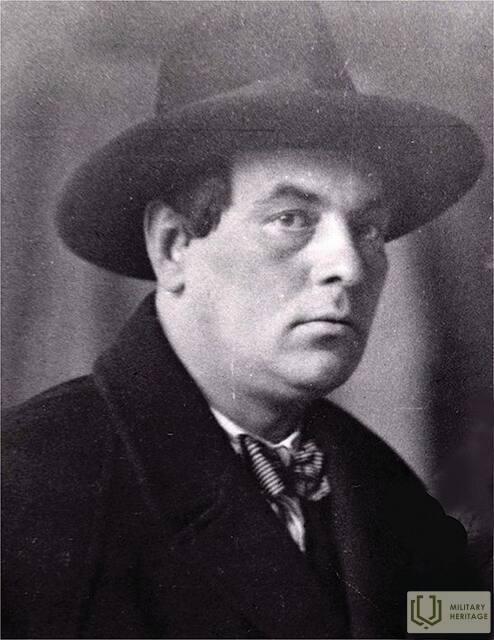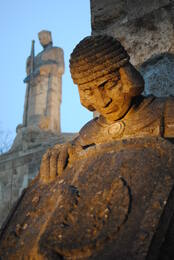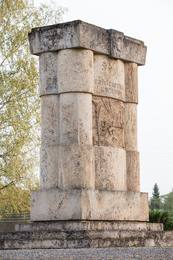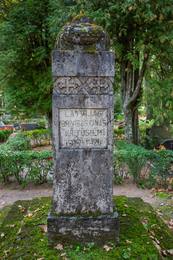Kārlis Zāle (1888 -1942), sculptor, master of Latvian monumental sculpture
Kārlis Zāle (real name Johans Kārlis Leonhards Zālīte) was born on November 28, 1888 in Mažeikai, Kaunas province. He studied at the evening courses of drawing, modeling and painting at the Liepāja city school, the Kazan art school (1909–1913), the workshop of the sculptor Stepan Erzya (С.Д.Эрзья) in Moscow (1914–1915), the Imperial School of the Society for the Promotion of Art in Petrograd (1916), the Higher Art School of the Petrograd Academy of Arts, the Petrograd State Free Art Workshops. For the purpose of his studies, he stayed in Berlin (1921–1923), and Italy (1926).
The most significant works of Kārlis Zāle are the sculptures of the Riga Brothers' Cemetery and the Freedom Monument. Kārlis Zāle created sculpture groups and decorative elements for the Brothers' Cemetery ensemble from 1924 to 1936 (architects Pēteris Feders, Aleksandrs Birzenieks, garden architect Andrejs Zeidaks). The ensemble includes 11 sculptures.
For the Freedom Monument in Riga (1931–1935, architect Ernests Štālbergs), Kārlis Zāle created the allegorical sculpture of Freedom (copper forging, gilding), groups covering the lower part of the obelisk, allegorical groups at the corners of the pedestal, two reliefs on the pedestal planes, and two reliefs on the outer surfaces of the terrace.
Kārlis Zāle created a sculptural frieze for the monument in Sudrabkalniņš, dedicated to the soldiers of the Riga Regiment who defended Riga in 1919 (1929–1937, architect E. Štālbergs), a monument to those who fell in the Latvian freedom struggle at the fraternal cemetery in Jaunpiebalga (1930, architect A. Birzenieks), to the riflemen who fell in World War I at Smārde Station (1936), to the residents killed near Ragana in 1941, and to the fallen members of the self-defense unit at the Inčukalns cemetery (1944, destroyed, restored in 1988). He has also created tombstones for individual individuals.
From 1936 to 1940, as well as from 1941 to 1942, Kārlis Zāle headed the Sculpture Workshop of the Academy of Arts. Kārlis Zāle was a member of the UL student society Konkordia Valdemārija.
Kārlis Zāle was a Grand Officer of the Order of the Three Stars (1935), a laureate of the Fatherland Prize (1938), and an Honorary Member of the Latvian Academy of Arts (1939).
Kārlis Zāle died on February 19, 1942, at his home in “Atvasītē” in Inčukalns parish, and was buried in the Riga Brothers Cemetery.
More information sources
Laila Bremša. Kārlis Zāle. National Encyclopedia: https://enciklopedija.lv/skirklis/34800
Vaidelotis Apsītis, Freedom Monument. - Riga, Zinātne, 1993.
Vaidelotis Apsītis, Brothers' Cemetery, Riga, Science.- 1995.
Riga Brothers' Cemetery. 1915-1936-2011., compiled by Guntis Gailītis.- Riga, Jumava, 2011.
Related timeline
Related objects
Brothers' Cemetery in Riga
Riga Brothers’ Cemetery is located in the northern district of Riga. The cemetery extends over an area of 9 ha and is the most outstanding and significant memorial ensemble in Latvia dedicated to the fallen Latvian soldiers. About 3,000 soldiers are buried here. The Brothers’ Cemetery was created during World War I after the first three Latvian Riflemen, who fell in Tīreļpurvs in the battle against the German Army, were buried here. Later Latvian soldiers who had died in other battles and wars would also be buried in the Brothers’ Cemetery. The memorial is based on the design of the sculptor Kārlis Zāle, and is the first memorial ensemble in Europe with such landscape, architecture and sculptural value. It uses elements typical to the Latvian landscape, traditional farmsteads, Latvian folklore and history that praise the characteristics of soldiers and tell the story of the way of the soldier. The memorial was unveiled in 1936 and it has three parts: ‘The Road of Though’ which is a 250 m long alley, ‘Terrace of Heroes’ with the Altar of the Sacred Flame and ensemble the Sacred Oak Grove, and the burial ground with the Latvian wall and a memorial of a mother with her fallen sons.
Monument to the soldiers who fell in the War of Independence
Located near the Jaunpiebalga St. Thomas Evangelical Lutheran Church.
A monument designed by sculptor Kārlis Zāles and architect Aleksandrs Birzenieks to the members of the Jaunpiebalga parish who fell in the War of Independence is visible.
The monument was unveiled on June 29, 1930. It was designed by sculptor Kārlis Zāle and architect Aleksandrs Birzenieks, but the forging work was carried out at the E. Kuraus stonemasonry in Riga. The monument is designed as an architectural arch. Two columns with a massive lintel are placed on a three-tiered terrace. Between the columns is a figurative relief – Mother blesses two wounded sons.
According to information provided to J. Lismanis by Jaunpiebalga Secondary School teacher Vēsma Johansone, an urn with a list of 125 fallen parishioners was placed at the foundation of the monument. However, the press of the time only mentioned 60 fallen. On the same day, a “Heroes’ Grove” was planted around the church – 60 oak trees.
The Evangelical Lutheran Church of St. Thomas in Jaunpiebalga was consecrated on July 4, 1804, but from 1871 to 1873 the church was rebuilt according to the design of Matthias von Holst. It has 800 seats, and the altar and pulpit are carved from oak. When the church of Jaunpiebalga celebrated its 200th anniversary, the church was named after St. Thomas.
The Jaunpiebalga Church, which is a cultural monument of national importance and the largest Lutheran church outside Riga, has played a major role in shaping the spiritual world of many outstanding creative personalities.
Military heritage monuments at the Dīvaliņas cemetery in Valmiera
Located in the Valmiera Dīvalas (Jānis) Cemetery in Valmiera.
A monument made of Allaži travertine, designed by sculptor Marta Lange and unveiled on September 26, 1937, is visible.
The pillar-shaped monument is topped by a sloping altar, on which stands a wreath of oak leaves and a helmet carved from travertine.
Approximately 80 soldiers who fell in the Latvian War of Independence, as well as those who died from injuries and diseases, are buried.
Nearby is one of the lesser-known works of Kārlis Zāles - the monument "Fallen Roses", which is associated with the creation of the Brothers' Cemetery ensemble.
Nearby is also a memorial to the victims of communist terror - a stone with the inscription: "To those murdered by the communist regime in 1941" and white crosses.
Sudrabkalniņš hill - memorial for fight against Bermondt army
Located in Riga, Pārdaugava, at the intersection of Slokas and Kurzemes avenues.
In early November 1919, during the Latvian War of Independence, street battles between the Latvian Army and Bermont's troops took place in Pārdaugava. The decisive attack on Bermont's army took place in this area. In 1937, a monument was unveiled in Sudrabkalniņš, according to the project of Kārlis Zāle, honoring the fallen soldiers of the 6th Riga Infantry Regiment and highlighting their military qualities.
Designed as a memorial wall – a symbolic fortification, the gate of which depicts a lion blocking the way to the enemy’s attack. Built from stone blocks of the Daugavgrīva Fortress defensive rampart and hewn from the granite left over from the Freedom Monument. The cost of the memorial site amounted to almost 35,000 lats. For comparison, 4 “Ford - Shield V8 De Luxe” cars made in Latvia could be purchased for this amount.
Today, you can visit one of the most impressive memorials of the War of Independence.
Monument "Grieving mother" at Inčukalns Cemetery of Honour
Located: Inčukalns municipality, Inčukalns, Miera Street, Inčukalns cemetery.
Monument opened: July 16, 1944. Monument opened after the death of K. Zāle. Inscription: For the fallen partisans of the Fatherland in 1941 (restored). Monument restored on November 5, 2020. Monument restored with the support of the Inčukalns Regional Council. Restorer artist Igors Dobičins.
Events: “On June 17, 1940, Latvia was occupied by the USSR. On June 14, 1941, deportations were carried out. On June 22, 1941, Germany attacked the USSR and units of the Wehrmacht entered Latvia. The Red Army and its supporters retreated. In many places in Latvia – including Ragana, Sēja and Inčukalns – former guards and patriotic young people organized themselves to protect their homes and rush to drive out the Soviet occupiers. When the flag of the Free State of Latvia was raised again in the “Ziediņi” (Flowers) neighborhood of Sēja parish on July 1, 1941, special units of the Red Army shot the landlady of this house – 39-year-old Elza Viša – at the Northern Cemetery, and her mother – 64-year-old Elza Martinova – at the border of Sēja and Krimulda parishes. This created even more hatred and indignation among the residents of the area, and they began to gather in the people's resistance movement and form self-defense units, which were also called the first partisans (the leader of the Inčukalns group was Maksis Cālītis). The fighters of the region were also joined by soldiers and officers from the so-called Latvian Territorial Corps who had escaped from the Litene military camp or who had been released. An armed clash with the Reds took place a few days later, on July 4, and seven soldiers and the son of the pharmacist from Ragana, Pēteris Prašķēvičs, died in the battle. In addition, the 17-year-old student of the Rēzekne Teachers' Institute, Jānis Porietis, was also wounded and taken prisoner in the Battle of Ragana, who was tortured, shot and buried near Straupe.
Here in Inčukalns, a common grave of brothers was dug out, to which coffins made of white unplaned boards were brought one by one in eight horse-drawn carriages, so that the fallen heroes could be laid to rest in their native land. A few months later, already during the German occupation, a monument designed by Kārlis Zāles (from 1939 until the end of his life on February 19, 1942, due to a serious illness, the brilliant Latvian sculptor chose Inčukalns as his place of residence) was installed in the cemetery - the image of a grieving mother over a rose lap. In the 1950s, local communist activists blew up the monument. The monument lay damaged and motionless until the Awakening, when in the late 1980s more and more people became interested and talked about the events of July 4, 1941 and called for the restoration of the Kārlis Zāles monument. This demand was voiced on September 8, 1988, at a meeting of the people and authorities convened at the Inčukalns Elementary School, which was attended not only by the residents of Inčukalns, but also by residents of nearby parishes, as well as members of the Environmental Protection Club and the Latvian National Union of Communists from Riga.
… The residents of Inčukalns actively participated in the restoration of the monument – Teodors Ildens, Arvīds Blaus, Pēteris Vorfolomējevs, … and many other patriotic people. On July 4, 1989, the newly reborn noble and sad monument was consecrated by the priest Vaira Bitēna in a solemn ceremony.”
Memorial sites of generals and knights of the Lāčplēsis Military Order in Trikāta parish
The memorial stele is located next to the Trikāta cemetery chapel.
The Trikāta cemetery preserves the memory of three outstanding Latvian generals - Roberts Dambītis, Kārlis Goppers and Jānis Balodis. The teacher of all these generals, Jēkabs Mūrnieks, is also buried in the Trikāta cemetery, for whom a monument made of travertine, modeled after Kārlis Zāle, was erected at the burial site in 1928.
The generals and knights of the Lāčplēsis Military Order are commemorated every year with torchlight processions to the Trikāta cemetery, where there are two memorial steles, in which a total of 17 names of knights of the Lāčplēsis Military Order associated with the Trikāta parish are engraved.
The stele was unveiled on November 11, 2018.
Video about the Lāčplēsis War Order and a set of orders that belonged to General Jānis Balodis.
Freedom Monument in Riga
The Freedom Monument was one of the central symbolic points of the Awakening events. On June 14, 1987, the human rights group Helsinki-86 organized an unauthorized public flower-laying ceremony at the Freedom Monument. Two months later, on August 23, Helsinki-86 called for a rally at the Freedom Monument on the 48th anniversary of the Hitler-Stalin Pact of August 23, 1939. During this rally, Soviet police beat and arrested demonstrators. In the following years, flower-laying ceremonies at the Freedom Monument became a part of all major demonstrations and other mass events .
Located in the center of Riga, on Freedom Square.
The Freedom Monument is one of the most outstanding monuments of Latvian history, architecture and art. Built according to the project of Kārlis Zāle with public donations. It was unveiled in 1935 as a symbol of the Latvian people's freedom and love of their homeland. Together with the Riga Brothers' Cemetery ensemble, it belongs to the most valuable examples of monumental architecture and sculpture.
The Freedom Monument expresses the ethical and aesthetic values of Latvian culture. The symbols reflect the philosophical essence of freedom and the historical ideas of the Latvian nation about the stages of the struggle for independence. They point to the embodiment of physical and spiritual strength. The heroic language tells the story of the Latvian people as self-reliant, active creators of history and the determinants of their own destiny.
In its place, there was originally a monument to Russian Tsar Peter I. During World War I, it was dismantled to be transported by ship to Petrograd. The ship was torpedoed by a German submarine, and it sank off the Estonian island of Vormsi. The Soviet occupation regime planned to demolish the Freedom Monument several times, but this did not happen.
Today, you can see one of the symbols of Latvia and observe the traditions of the army honor guard.
A tactile Freedom Monument has been created on the canal bank, next to the Freedom Monument. This special bronze miniature was created by sculptor Ivars Miķelsons on a scale of 1:50.
Related stories
In memory of Oskars Kalpaks
The memory of Oskars Kalpaks is preserved in many places – this is evidenced by his native Liepsalu house, a monument in the Visagala cemetery, commemorative events and beautiful concerts on March 6, the Meirānu Kalpaks Elementary School, streets in Lubāna, Madona and other cities, and on and on. But in this article – about the preservation of the memory of Oskars Kalpaks in his native region in the 1920s–1930s.











